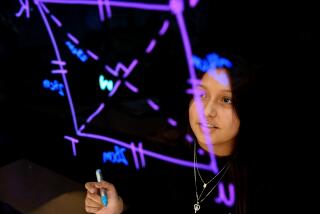The Vital New Partnership Needed for Science Education : U.S. problem: A nation with great science is not teaching it well enough
One has to travel no further than Kathleen Dienerâs fifth-grade class at the Madison School in Pasadena to find hope for remedying the appallingly inferior education our youngsters get in science. The other morning her pupils, mostly Latinos with limited English skills, were engrossed in a lesson on electric circuits, using kits of batteries, paper clips and bulbs. It was one of many âhands onâ science lessons now used in all 525 elementary school classrooms in Pasadena. The project, designed jointly by the district and Caltech scientists, has drawn wide national attention in a broadening attack on the crisis in science education.
That crisis is above all a crisis of primary schools, where teachers typically have little training in science and where youngstersâ instinctive fascination with the natural world is often snuffed out. We must start here to reverse the years of neglect that have left Americans woefully unprepared for the technological future. âWe do not need huge numbers of scientists, but huge numbers of scientifically trained people,â says Bruce M. Alberts, president of the National Academy of Sciences.
Two elements are key to reform. First, schools must rethink science teaching, focusing more on the process of discovery than on fact accumulation like memorizing the periodic table of elements. âThatâs out,â says Gordon Ambach, executive director of the Council of Chief State School Officers. âThe new pedagogy is discovery, not just cookbooks.â Second, laboratory scientists in universities and industry must come into the schools to help teachers understand science and integrate it into other subjects like reading. Rather than vaunt their superiority, the scientists should collaborate with teachers and respect their pedagogical skills.
Thus in the Pasadena program, Science for Early Educational Development (SEED), about 50 Caltech scientists, with a National Science Foundation grant, helped teachers create a new curriculum. In it, even first-graders get a taste of science by growing seeds and watching frogs emerge from eggs and tadpoles. These are not just isolated projects but part of a systemwide program in which every elementary school pupil and teacher in Pasadena spends three hours a day on science for six to eight weeks a term.
Similarly, in San Francisco, more than 400 scientists and doctors at UC San Francisco have volunteered to help 350 teachers in middle schools and high schools. That partnership has shown that science can be taught well in depressed inner-city areas.
Science teaching in American high schools is outmoded, based on a âlayer-cakeâ approach in which students take biology first and then-- maybe --chemistry and physics. Under a $4-million grant from the NSF, the National Science Teachers Assn. will soon test a new method by which the close relationships between these disciplines are recognized so that students learn, for example, the necessary chemistry and physics while studying DNA genetics. This âScope, Sequence and Coordinationâ project will be tested in 15 high schools, including three in San Diego.
Other curricular reforms are supported by the Howard Hughes Medical Institute, the American Assn. for the Advancement of Science and even the Defense Department, which has made a $5-million grant to help laid-off defense workers retrain to work as science teachers in the Los Angeles Unified School District.
All this is welcome, but so far the reforms have been isolated and piecemeal. A more thoroughgoing âsystemicâ change is needed, not easy in a country where schooling is so decentralized. A potential help in this will be the new National Science Education Standards, due from the National Research Council by yearâs end. Long awaited, they are to be voluntary standards--for school systems, teachers and course content in everything from physics to the history of science.
After decades of neglect, science has again won priority in American education. We have the curricular and intellectual resources. The question now is how to get past the financial and institutional barriers to using them.
Next week: Overcoming obstacles to reform.
Better Trained Teachers Needed
Percentages of biology and chemistry teachers who lack state certification in those subjects.
Biology Chemistry California 18% 17% Florida 19% 3% Mississippi 20% 25% New York 8% 7% Sout Carolina 8% 6% North Dakota 0% 0% Total* 9% 8%
*32 states Source: Council of Chief State School Officers
More to Read
Sign up for Essential California
The most important California stories and recommendations in your inbox every morning.
You may occasionally receive promotional content from the Los Angeles Times.










